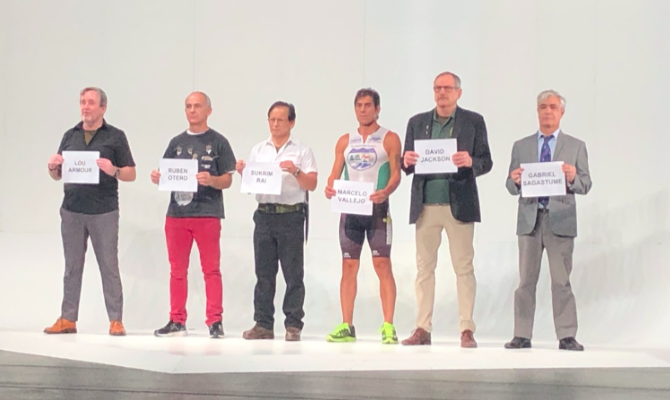Walking into the Aloysius P. Kelley Theatre on Jan. 28 was an odd sight. The Regina A. Quick Center for the Arts had set up a large screen on the stage with a makeup desk on the left and a desk with a projector in front of a cabinet cluttered with paper on its right. The screen would be down for the entire show for the projection of photos and films. In the back, a guitar and drums could be seen. People speaking both Spanish and English were set up in the middle sections of the theatre as the show started and the lights dimmed. This would open to one of the most interesting shows I’ve seen.
“Minefield”’s main cast was made up of veterans of the Falklands War (1982), from both the Argentinian and British sides. In the scene where the audience is introduced to them, we see these veterans as regular people, looking no different than any person you might find on the street. We learn that Lou Armor, Sukrim Rai and David Jackson fought for Britain while Ruben Otero, Marcelo Vallejo and Gabriel Sagastume were Argentinian soldiers. Above the stage, a small screen translated what each member said into either English or Spanish, the opposite of whichever language the actor spoke.
The show followed the timeline of the Falklands War. Each cast member was drafted by their respective countries and shared their time in the war through photos and dates from a particular day shown on the large screen. Through costumes and souvenirs, the audience would learn what each member had seen through performed reenactments, such as seeing comrades die or almost losing their lives. Most notably, the cast would give their own perspectives on certain events that occured. For example, the sinking of the Belgrano on May 2, 1982 is covered in depth by Ruben Otero. After crossing into British territory, submarines attacked and sank the boat. In the eyes of Otero, the sinking was frightening as he and other crew members waited out on a lifeboat for aid. The lifeboat floated for days as the crew, anxious, would shout for any assistance they spotted until they were saved. For the British, it was justified given the circumstances of war, and was not given a second thought.
Something that brought the show together were the acts done to present a visual example of events. A scene with a grown man stripping in front of a band is used to explain to the audience what went on in the British side of the war. Humor aside, some of the more dramatic moments were done with only six veterans acting out their memories, while the majority of the crew handled stage effects like lights and projections. From a minefield accident in Wireless Ridge on the Argentines’ own men to the deportation of Argentine soldiers back to Argentina by British forces, “Minefield” sets out to recreate the aspects of war that most films now would over-glorify or ignore. The way the cast were able to work together to present such a powerful show amazed me. Six people had the talent and acting skill to show their history off as what it was supposed to.
Each scene gives the basic understanding of what happened during the war to the aftermath. From archive footage to magazines in the other’s country, members would explain what each country was thinking, where some could even point themselves out in the pictures and film on the screen. There were two countries that were bent on winning against the other, inspired by news and pop culture that they produced. One archive footage was a anthem of sorts to describe the power Argentina had to defeat the British. Letters and mementos that the veterans had kept help illustrate that these weren’t extras seen on movies where people just shoot everywhere and have epic endings, but rather the harsh and traumatic lifestyle that one can experience in combat. “Minefield” is a wonderful play that deserves the praise and applause it works for itself.


Leave a Reply